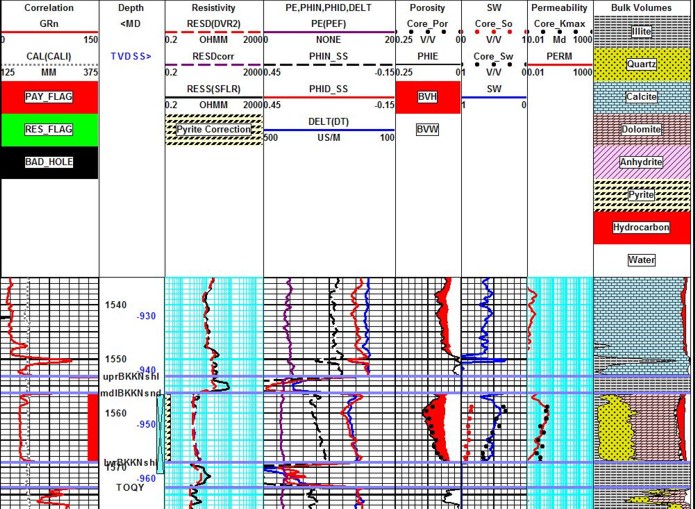|
 CALIBRATING
PERMEABILITY
CALIBRATING
PERMEABILITY
The usual approach to calibrating
permeability is to crossplot core porosity versus
permeability and obtain a regression line. Unfortunately
this presumes that the rock type does not change over the
interval. But the technique is widely used anyway. The
porosity - irreducible water saturation (Wyllie-Rose)
equation offers some improvement when pore geometry varies,
but regression is more difficult due to the multiple
variables.

A poor quality regression because
data is clustered,

 Good quality regression with a wide spread in porosity. because data
has a good distribution of porosity.
Good quality regression with a wide spread in porosity. because data
has a good distribution of porosity.
If there is more than
one rock type in the interval, several trend lines may be
evident. If data is a large splash on the plot, try to reduce
scatter by zoning rock types. In fractured reservoirs, some data
points with high perm and low porosity should be excluded from
the curve fitting so that a matrix permeability is obtained
separately from fracture permeability.
A good feel for the
quality or usefulness of log analysis permeability can be
obtained by crossplotting predicted productivity with actual
initial productivity. Average the third to ninth month
production to get a realistic initial production value.
Calibrating to this data will compensate for completion
hardware, stimulation, fluid type, and reservoir conditions that
could not be handled with our simplified math. This is not a
very reliable approach, especially in fractured reservoirs, but
it is better than not checking.
Drill stem test flow
rates, AOF, and IPR data can also be used. Be careful to compare
log analysis results from only the tested interval.
The best calibration
tool is feedback from a reservoir simulation. If a history match
can be obtained based on the reservoir description, all is well.
If reservoir volume has to be augmented or permeability doubled
to get a match, then the log analysis or the reservoir maps need
help. Frank and intelligent discussion between all disciplines
in the analysis team will usually find where calibration is
still needed.
 PERMEABILITY EXAMPLES
PERMEABILITY EXAMPLES
A depth plot comparison of
log analysis versus core analysis permeability provides a good
comparison method, often more useful than regression. The
calibration can be done by trial and error, varying the parameters
as needed to get a better match.

Good match between log and core porosity (Track
5). Usually adjusting the constant term in the permeability equation
will move the log analysis result enough to match the core data. The
other exponents seldom need to be changed.

Somewhat poorer match between log and core permeability due to very
thinly laminated porosity - permeability environment. Since the logs
average a 3 foot interval, and the core data can be measured at a
much finer increment, a perfect match is not possible.
However, a slightly higher constant term would
improve the calibration.
ines are log analysis.

Bakken “Tight Oil” example showing core porosity (black dots), core
oil saturation (red dots). core water saturation (blue dots), and
permeability (red dots). Note excellent agreement between log
analysis and core data. Separation between red dots and blue water
saturation curve indicates significant moveable oil, even though
water saturation is relatively high. Log analysis porosity is from
the complex lithology model and lithology is from a 3-mineral PE-D-N
model using quartz, dolomite and pyrite.
|

